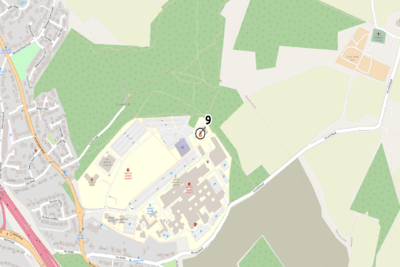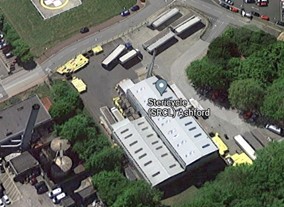Ashford Clinical Incinerator: Difference between revisions
add page specific text |
|||
| (6 intermediate revisions by 2 users not shown) | |||
| Line 1: | Line 1: | ||
{{#vardefine:epr|HP3230XA}}[[Category:High Temperature and Clinical Waste Incinerators]] | {{#vardefine:epr|HP3230XA}}[[Category:High Temperature and Clinical Waste Incinerators]] | ||
[[Clinical Waste Incinerator]] operated by [[SRCL]] and located adjacent to [[The William Harvey Hospital]] in Ashford, Kent. | [[Clinical Waste Incinerator]] operated by Stericycle ([[SRCL]]) Ltd and located adjacent to [[Wikipedia:William Harvey Hospital|The William Harvey Hospital]] in Ashford, Kent. | ||
{{ClinIncin|EPR={{#var:epr}}|id=9}} | {{ClinIncin|EPR={{#var:epr}}|id=9}} | ||
[[File:Ashford.jpg|305px|left|Ashford Clinical Incinerator, SRCL - Google Aerial Picture Captured June 21, all rights reserved]]__TOC__ | [[File:Ashford.jpg|305px|left|Ashford Clinical Incinerator, SRCL - Google Aerial Picture Captured June 21, all rights reserved]]__TOC__ | ||
| Line 6: | Line 6: | ||
==Summary== | ==Summary== | ||
[[Clinical Waste Incinerator]] operated by [[SRCL]] and located adjacent to [[The William Harvey Hospital]] in Ashford, Kent. | [[Clinical Waste Incinerator]] operated by Stericycle ([[SRCL]]) Ltd and located adjacent to [[Wikipedia:William Harvey Hospital|The William Harvey Hospital]] in Ashford, Kent. | ||
The Ashford plant [[Incineration|incinerates]] [[Clinical Waste|clinical waste]], including [[Clinical Waste|clinical wastes]] classed as [[Hazardous Waste|hazardous]] under the [[Hazardous Waste (England and Wales) Regulations 2005]]. The bulk of the [[Clinical Waste|waste]] is produced at hospitals, but also includes smaller quantities from doctors’ surgeries, dentists, health clinics, residential and nursing homes, and from medical research facilities. The [[Hazardous Waste|hazardous wastes]] [[Incineration|incinerated]] include infectious waste and waste containing [[Healthcare Waste|cytotoxic or cytostatic medicines]]. The plant also [[Incineration|incinerates]] small amounts of specialised wastes where it is recognised that [[High Temperature and Clinical Waste Incineration|high temperature incineration]] represents the best [[Disposal|disposal]] option. | |||
==Plant<ref name="Adden">Annual Performance Report 2020</ref>== | ==Plant<ref name="Adden">Annual Performance Report 2020</ref>== | ||
The [[Incineration|Incinerator]] is designed to process 1000 kilograms per hour. The [[Incineration|incinerator]] is of stepped [[Grate|hearth]] design, with three main [[Combustion|combustion]] [[Grate|hearth]] and an [[Incinerator Bottom Ash|ash]] box. [[Healthcare Waste|Healthcare Wastes]] are loaded mechanically direct from the wheeled bins used to deliver the [[Clinical Waste|waste]]. | |||
The [[Clinical Waste|waste]] is charged onto the first [[Grate|hearth]] where the [[Combustion|combustion]] process commences. Hydraulic rams operate at intervals to push the [[Clinical Waste|waste]] along the first [[Grate|hearth]], until it falls off the end onto the second [[Grate|hearth]] where it burns vigorously at a temperature of between 850°C and 1000°C, where it burns out to produce an [[Incinerator Bottom Ash|ash]]. This [[Incinerator Bottom Ash|bottom ash] and any remaining part-combusted [[Clinical Waste|waste]] is then pushed along the [[Grate|hearth]], where the fixed carbon in the ash is further burned out. The residues are then dropped into an [[Incinerator Bottom Ash|ash]] pit the end of the process. | |||
The [[Flue Gas|flue gases]] from the [[Incineration|incineration]] process are passed through a secondary chamber, or afterburner, where any gaseous products of [[Combustion|combustion]] are burned out under oxygen rich conditions. This stage is designed to destroy any [[Wikipedia:Carbon monoxide|carbon monoxide]], [[Wikipedia:Volatile organic compound|volatile organic compounds]], and [[Wikipedia:Dioxins and dioxin-like compounds|dioxins]] and [[Wikipedia:Furan|furans]] produced by the [[Combustion|combustion process]]. | |||
The [[Flue Gas|flue gases]] are then cooled by directing them through a waste-heat boiler before they pass into the abatement section of the process. Powdered [[Wikipedia:Lime (material)|lime]] and powdered [[Wikipedia:Activated carbon|activated carbon]] are added to the [[Flue Gas|flue gases]] entering the abatement process to remove acid gases, [[Wikipedia:Heavy metals|heavy metals]] and residual [[Wikipedia:Dioxins and dioxin-like compounds|dioxins]] and [[Wikipedia:Furan|furans]] before discharge to atmosphere from the stack. The [[Flue Gas|flue gases]] being discharged from the [[wikipedia:Chimney|stack]] are continuously monitored. | |||
The [[Incineration|incineration]] process produces two residues; [[IBA|bottom ash]] and [[APC Residues|spent lime]]. | |||
{{EAIn|EPR={{#var:epr}}}} | {{EAIn|EPR={{#var:epr}}}} | ||
==References== | ==References== | ||
Latest revision as of 07:27, 25 June 2021
Clinical Waste Incinerator operated by Stericycle (SRCL) Ltd and located adjacent to The William Harvey Hospital in Ashford, Kent.
| Ashford Clinical Incinerator | |
 See HT & Clin → page for a larger UK Wide map. | |
| Waste Licence | HP3230XA |
| Operator | SRCL |
| Operational Capacity | 8,500tpa |
| Number of Lines | 1 |
| Region | South East |
Annual Report Data
| Year | Total In | Total Clinical | IBA Out | ACP Out | Op Hours
|
|---|---|---|---|---|---|
| 2019 | 8059 | 8059 | 792 | 486 | 8015 |
| 2018 | |||||
| 2017 | |||||
| 2020 | 8013 | 8013 | 758 | 595 | 8072 |
| 2021 | 8209 | 8209 | 799 | 631 | 8060 |
| 2022 | 7856 | 7596 | 829 | 577 | 7150 |

Summary
Clinical Waste Incinerator operated by Stericycle (SRCL) Ltd and located adjacent to The William Harvey Hospital in Ashford, Kent.
The Ashford plant incinerates clinical waste, including clinical wastes classed as hazardous under the Hazardous Waste (England and Wales) Regulations 2005. The bulk of the waste is produced at hospitals, but also includes smaller quantities from doctors’ surgeries, dentists, health clinics, residential and nursing homes, and from medical research facilities. The hazardous wastes incinerated include infectious waste and waste containing cytotoxic or cytostatic medicines. The plant also incinerates small amounts of specialised wastes where it is recognised that high temperature incineration represents the best disposal option.
Plant[1]
The Incinerator is designed to process 1000 kilograms per hour. The incinerator is of stepped hearth design, with three main combustion hearth and an ash box. Healthcare Wastes are loaded mechanically direct from the wheeled bins used to deliver the waste. The waste is charged onto the first hearth where the combustion process commences. Hydraulic rams operate at intervals to push the waste along the first hearth, until it falls off the end onto the second hearth where it burns vigorously at a temperature of between 850°C and 1000°C, where it burns out to produce an ash. This [[Incinerator Bottom Ash|bottom ash] and any remaining part-combusted waste is then pushed along the hearth, where the fixed carbon in the ash is further burned out. The residues are then dropped into an ash pit the end of the process.
The flue gases from the incineration process are passed through a secondary chamber, or afterburner, where any gaseous products of combustion are burned out under oxygen rich conditions. This stage is designed to destroy any carbon monoxide, volatile organic compounds, and dioxins and furans produced by the combustion process.
The flue gases are then cooled by directing them through a waste-heat boiler before they pass into the abatement section of the process. Powdered lime and powdered activated carbon are added to the flue gases entering the abatement process to remove acid gases, heavy metals and residual dioxins and furans before discharge to atmosphere from the stack. The flue gases being discharged from the stack are continuously monitored.
The incineration process produces two residues; bottom ash and spent lime.
Waste Tonnage, By Origin
The table shows a list of the Waste for the Permit HP3230XA, that has arrived into sites as reported to the Regulator and then publicised in their reported statistics. The Data used is from the most recent returns. The total reported tonnage arriving at the site was: Expression error: Unexpected < operator.t.
Where this tonnage exceeds that reported in year of the corresponding annual report, this may be due to the following reasons:
- Tonnage may have been received but not incinerated, i.e. the material is held pending incineration (the operator return to the EA reports as received whereas the annual report focuses on when the waste is incinerated.)
- Material may have been received into the site but treated in some other way than incineration.
- Material may have been received on the but transferred out of site for disposal/treatment at another site rather than incineration on the site.
| EWC Code | Origin of Waste | Tonnes In |
|---|
References
- ↑ Annual Performance Report 2020
